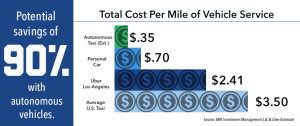Written By: D’Antione Copeland, Lee Fauteux, Bobby Peddireddy and Gina Romero, Global MBA Class of 2018
Among the many benefits of Mobility as a Service (MaaS), the most tangible benefit will be a more affordable and robust transportation ecosystem. Currently, commuters in Los Angeles spend an average of $2,600 annually or an average of $10 per day on a round-trip commute to the office. For tomorrow's MaaS, autonomous vehicles (AV), could soon be the lifeblood of tomorrow’s Smart Cities. As urban populations grow and as Smart Cities emerge, city leaders face a growing challenge: offering Mobility as a Service and investing in adequate transportation infrastructure that will serve the needs of the public and provide an economic boost.
The emerging technology of AV and MaaS business models have introduced an array of business ventures beyond traditional ride hailing service providers, such as Lyft and Uber. General Motors and Waymo are now joining the race to provide autonomous vehicles, related technology, and fleets. These new business models hold out the prospect of an improved transportation ecosystem that can reshape the urban landscape of tomorrow’s Smart Cities. More importantly, the rise of the MaaS network will significantly decrease consumer cost and timeliness of point-to-point mobility.
According to an ARK Investment Report, autonomous taxis will cost commuters a mere $.35 per mile, approximately a 90% savings over today’s average.1 The economic savings is predicted to drive national adoption of an autonomous taxi network. Analysts predict that by 2035, autonomous taxis will be the dominant MaaS for door-to-door mobility.
Research shows that autonomous taxis will add $2 trillion to the U.S. GDP alone and exceed $10 trillion in gross revenue by 2035, while the costs associated in implementing the necessary infrastructure is estimated to be $2 trillion over the next 10 years, a small, yet smart investment for a big return.2 City planners and leaders need to now proactively invest in smart infrastructure, robust 5G networks, fully autonomous inductive charging stations (Vehicle to Electric Grid) and curbside pickup/drop-off locations for AVs, to make these savings a reality.
This blog is part of a series created under the direction of Bonnie Pierce, Lecturer in Strategic Management and Public Policy, for the GW Business School class “Business and Society: Autonomous Vehicles.”
1 ARK Investment Management LLC, "Mobility-as-a-Service: Why Self-Driving Cars Could Change Everything", October 2017
2 Uber Fare Estimator, as of January 13th, 2018



